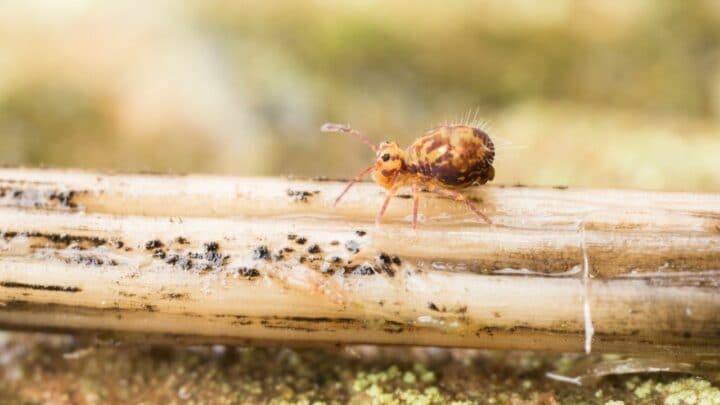Springtails are common but harmless pests found in homes and gardens anywhere in the world.
They are non-flying hexapods that generally infest compost heaps, leaf litter, and lawn soil, as they love living in areas that are moist, humid, and full of decaying plant matter.
They benefit the environment by contributing to the breakdown of nutrient cycles in the soil through their feeding habits.
What do springtails eat?
In their preferred environments, springtails feast on decaying plant matter, insect excrement, fungi, mold, bacteria, mildew, lichens, algae, and sometimes on the smallest roots of plants. Carnivorous or predatory breeds of springtail will eat carrion when it is available or other very tiny invertebrates.
What Springtails Like to Eat
Springtails are like the tiny vacuum cleaners of the ground and will happily thrive on decaying organic matter. Decomposing leaves and roots are a typical meal for springtails, and they also really enjoy fungal and bacterial matter such as mold, mildew, algae, and fungi.
Occasionally, they will nibble on live matter like the tiniest roots of young plants, but usually, they prefer to scavenge for snacks that are already rotting or decomposing.
Some species are also known to consume the excreta of other ground-dwelling invertebrates.
Indeed, several species of carnivorous springtails also snack on carrion when available, on other tiny invertebrates, or even on other springtails.
For the most part, though, the springtails found in our gardens are the omnivorous variety, and they serve a unique purpose when it comes to the nutrient cycles in soil.
How Springtail’s Diet Benefit the Ecosystem
Springtails contribute positively to recycling nutrients in the ground and indirectly speed up the decomposition of plant matter.
‘Their diet of decaying plants, leaves, and roots contributes to mineralization in the soil and soil’s surface structure by default. Together with this, their consumption of fungi and bacteria assists in beneficially regulating these microorganisms.
By eating fungi in large quantities, springtails can prevent the overdevelopment of certain diseases via fungal pathogens, thereby protecting plants from illness.
In addition to this, they also aid in spreading beneficial spores and bacteria through their digestive tracts. Their fecal excretions are dense in nutrients and serve as good breeding grounds for other valuable microorganisms.
On rare occasions, springtails can cause damage to young plants and seedlings by overindulging on their roots.
This is usually the case when there is a lack of other sustenance available or a severe infestation in a growing house. Some springtail species in particular target and damage crops.
Springtails do not do well in soil with a high concentration of metals. This means they will be far less abundant in areas close to roads, foundries, mines, major urban developments, or marshaling yards.
The same applies to soil that is treated with pesticides. As springtails cannot move far enough to seek refuge, they may incidentally become collateral damage in attempting to prevent other insects and illnesses.
Where Springtails Live
It is normal for homeowners to share their gardens with springtails unwittingly, and many may never even be aware of it. These tiny bugs are as small as fleas and tend to stay out of sight unless disturbed.
Springtail’s habitats include compost mounds, leaf litter, soil, mulch, or any area really where there is decaying plant matter or wood.
Growing houses and greenhouses are also attractive to them, as these are moist, humid environments. Often, they can also be found on the surface of stagnant water, such as the top of swimming pools or still ponds.
Should one have the misfortune to have an indoor springtail invasion, the chances are they will pick a nice houseplant to live in as it can provide them with sustenance.
They also enjoy drains and humid crawl spaces but generally cannot survive in these locations without access to food.
Up to 10 000 springtails may occupy a single square meter of soil, so long as there is adequate food for them to live on.
Frequently Asked Questions about What Springtails Eat
How do springtails drink water?
Springtails absorb water through a tubular vessel located beneath their abdomens. These tiny bugs lose moisture quickly and therefore need to live in damp environments to survive. Without sufficient water absorption, they cannot survive, which is why so often, if they invade a home, they perish from lack of sustenance.
How long do springtails live?
This depends on the environment and temperature they live in. In poor conditions, springtails may only live for a week or two. In environments where they can thrive, they can live for up to three years.
Why are there springtails in my house?
Although beneficial to the ecosystem, springtails can be a real pest if they enter the home. Springtails do this since they’re attracted to a damp or humid area, like a drain or climb space. Another reason is that they are attracted to light and may mobilize themselves into one’s property via plumbing vents, cracks in the wall, or windows as a result.
Conclusion
Springtails certainly serve a purpose in the soil and do their due diligence to contribute to the environment.
Due to their microscopic size, we may never even see them, but rest assured that in most gardens, they are merrily munching away at decomposing plant matter and forming a valuable part of the tiny world beneath the soil.


